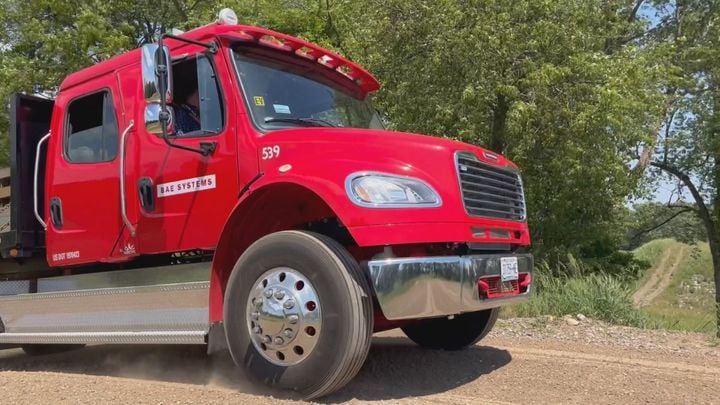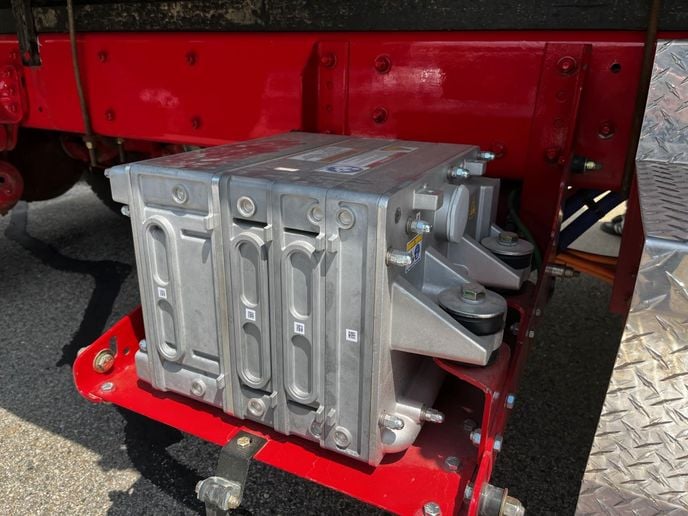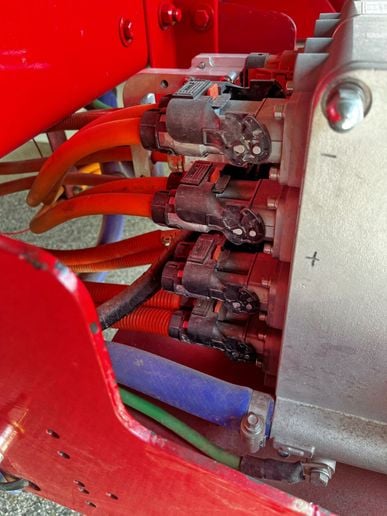Trucker Access › Forums › Diesel News › Electrification Simplified, BAE Style – Part 2 – Fuel Smarts
- This topic has 0 replies, 1 voice, and was last updated 9 months, 1 week ago by
 EazyRiDer66.
EazyRiDer66.
-
AuthorPosts
-
June 27, 2024 at 5:45 am #27484
 EazyRiDer66Keymaster
EazyRiDer66Keymaster

The BAE-Eaton demonstrator truck is a 2018 Freightliner M2 Class 7 cab and chassis — formerly a diesel — purchased from a used truck dealer for this project.
Editor’s note: Eaton and BAE Systems have teamed up to bring an innovative new approach to electric powrtrains for commercial vehicles. HDT Executive Editor Jim Park traveled from his beloved Montreal, Canada, down to the Eaton Proving Grounds outside of Marshall, Michigan. This is Part 2 of his in-depth, three-part report on the new, lightweight BEV powertrain being developed by Eaton and BAE Systems.
There’s a new kid on the block with some fresh ideas on how to build electric trucks.
And keep-it-simple is their mantra.
The strategy is to eliminate as many parts and as much weight as possible through modularity and integration, along with a new way of thinking about power electronics.
A New Partnership Bears Fruit
Last year, BAE Systems struck a deal with Eaton to migrate its electric drive technology from the transit bus market into the medium- and heavy-duty truck market.
Part 1 of my report from Marshall is on this interesting collaboration developing between Eaton and BAE systems and how that relationship is growing. Part 2 and Part 3 of my story digs a bit deeper into the results of their efforts, so far.
The first love child to emerge from the BAE-Eaton partnership is a medium-duty Class 7 demonstrator truck chassis.

The high voltage power distribution unit is centrally located between the batteries and the motor to help minimize the cable run.
The truck itself is a 2018 Freightliner M2 Class 7 cab and chassis — formerly a diesel — purchased from a used truck dealer for this project.
Daimler and Freightliner were not involved in its transformation into an electric vehicle.
The truck has a gross vehicle weight rating of 33,000 lbs. and can carry a payload of 18,000 lbs. It weighs just 1,400 lbs. more than the diesel chassis from which it was built.
It has battery capacity of 230 kWh in three modules. It’s powered by 185 kW (continuous) (250-hp) center-drive motor driven through an Eaton automated-manual 4-speed transmission and a Meritor drive axle with a 3.9:1 ratio.
The truck is capable of 70 mph sustained highway speed in 4th gear (electronically limited). It can also start on grades greater than 21%. BAE says energy consumption is 1.1 kWh/mile at full gross weight.
The extensive consolidation and integration BAE brought to this demonstrator yielded a weight reduction of about 50% compared to a typical first-generation Class 7 EV chassis.
Additionally, the overall EV parts count dropped from 145 to 69. This includes significant reductions in high-voltage cable, connectors, coolant lines and fittings, components and component mounts.
Not only are there fewer parts and much less heavy high-voltage cable, but this configuration also frees up a lot of chassis real estate — which could be useful in vocational applications.
Modularity and Integration
BAE’s approach is to eliminate as many of the individual controllers and inverters as possible and run all the accessory loads through a single integrated inverter.
In the case of the demonstrator, that means three separate inverters (air brake compressor, AC compressor and coolant pump) are rolled into a single module designed from the start for expansion.
Additional modules or “slices” can be added to the unit, providing power for additional accessory loads.
Another unit, the high voltage power distribution unit, houses the traction inverter as well as battery connections and slow and fast charging connections as well as the three-phase inverter and a DC output for high-voltage accessories.
Again, it’s a modular design allowing for additional slices or modules for expansion.
“We think of any electric as vehicle as two separate systems, the accessory systems for all your air brakes, power steering, air conditioning, etc., and the other half is the main power loads,” explained Derek Matthews, BAE’s global partnership manager and senior business development manager. “So, high-voltage-high power and high-voltage, low-power.”
Matthews also offered this slightly more colorful explanation: “When was the last time you lifted the hood on a truck and went, ‘oh, there’s the four-cylinder engine that drives my rear wheels. Look, here’s the little one-cylinder engine that runs my air compressor, and I got another little one cylinder here to drive my power steering?'” he asked during the walk-around, only half joking.

The inboard side of the DC/DC Convertor module. It’s where all the HV cables, charging cables and control cables come to a single central point on the chassis.
Then, sweeping an arm around the more or less empty engine compartment, he added, “Our argument is that this is basically an electric engine.
“We learned early that we need to address the most complicated component first — the one that’s got the most regulatory and safety requirements around it — and manage it once,” he said. “Everything else, all the accessories, is a load.”
Emissions vs Electric
Then, sealing the case for a unified and managed power management system, Matthews said that while electric trucks no longer have emissions regulations to contend with, manufacturers now have to deal with cybersecurity requirements (which change regularly) and high-voltage safety, specifically, SAE’s recommended practice ISO 26262. It defines functional safety requirements of electrical and/or electronic systems installed in serial production EVs.
“That’s just like the emissions requirements were in terms of level of effort and NRE (non-recurring engineering cost) for the design,” he pointed out. “Do you really want six different suppliers trying to keep up with that? And while choice is important, how many companies that make air brake compressors are also going to be able to give you a million-mile high-voltage inverter that can survive years of rugged use and meet all the cybersecurity requirements that change all the time and will meet ISO 26262?
“And you’re going to do that across six or seven different components and keep everybody in sync on software when you do software upgrades because that’s always easy. Right?”
In Part 3 of his look at the Eaton-BAE electric truck technology partnership, Jim Park looks at what digs into the design and configuration of the powertrain and Eaton’s role in reducing vehicle weight with new EV transmission and regen technologies.
-
AuthorPosts
- You must be logged in to reply to this topic.